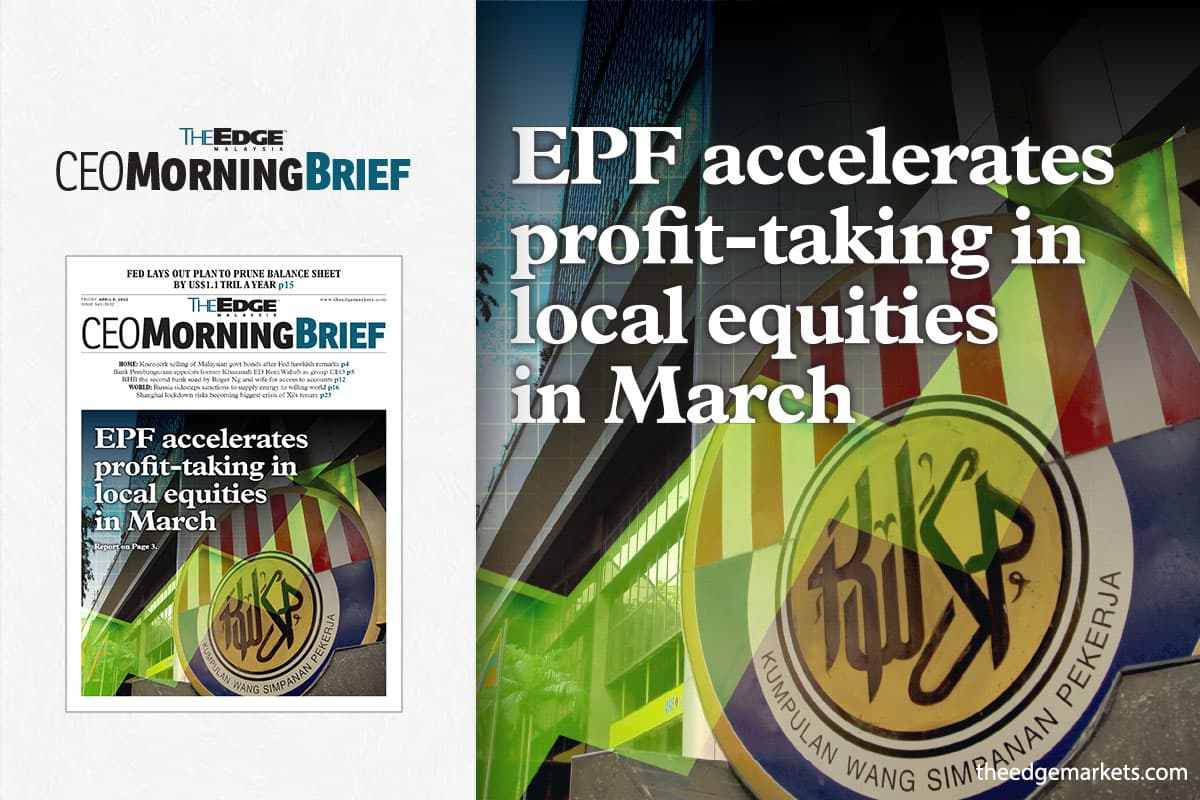
KUALA LUMPUR (April 8): The Employees Provident Fund (EPF), which is slated to roll out its fourth round of voluntary withdrawals since the Covid-19 pandemic, has accelerated selling in key Malaysian equity holdings in March, largely in the banking and plantation counters.
Bursa Malaysia filings showed that EPF increased its disposals in March-to-date across key holdings including 65.73 million shares in Sime Darby Plantation Bhd equivalent to a 0.95% interest from 0.78% in February, followed by 0.21% in Public Bank Bhd (reversing from February’s 0.05% net buy) and 0.18% in Malayan Banking Bhd (Feb: 0.14% sold) (see table).
Other significant disposals in March-to-date include IOI Corp Bhd, Kuala Lumpur Kepong Bhd, Hap Seng Plantations Holdings Bhd and Alliance Bank Malaysia Bhd, according to bourse filings. The retirement fund also sold more shares of YTL Corp Bhd and RHB Bank Bhd, compared with February.
In the first quarter of 2022 (1Q22), EPF’s largest disposals by shareholding occurred in plantation counters Sime Darby, FGV Holdings Bhd and IOI Corp (see chart). Among trading stocks in its stable where the retirement fund is not a substantial shareholder, the EPF was also a net seller in Malakoff Corp Bhd, Eco World International Bhd, Dagang NeXchange Bhd, and TSH Resources Bhd in the period.
Of its top 50 disposals by shareholding position, EPF saw accelerated selling in 42 counters in 1Q22 compared with 4Q21. Conversely, out of its top 50 acquisitions, the fund ramped up buying in 36 counters in the period compared to the quarter before.
Stocks that EPF added during the quarter include CTOS Digital Bhd, Inari Amerton Bhd, CIMB Group Holdings Bhd, IHH Healthcare Bhd, Mi Technovation Bhd, and Dialog Group Bhd.
EPF joined local institution funds as net sellers in 1Q2021 with RM6.8 billion in net selling, where the shares were taken up by foreign institutions who recorded net buying of RM6.4 billion in the period.
The rotation, last seen before the pandemic, came on the back of improved sentiment towards economic recovery as Malaysia reopened its borders, and as foreign investors sought alternatives away from Europe due to the Russia-Ukraine geopolitical conflict. One of the reasons Malaysia is seen as a viable option is due to its exposure towards the commodity markets, namely oil and gas, and palm oil.
Year-to-date, the Bursa Malaysia Plantation Index is still up 27.24% after coming off its record high of 8,782.59 on March 3, whereas the Bursa Malaysia Financial Services Index is up 7.73% in the same period.
Year-to-date, shares in Hap Seng Plantations have jumped 40.7% or 81 sen to settle at RM2.80 on Thursday (April 7) from RM1.99 on Jan 3, followed by Sime Darby Plantation which has surged 36.71% or RM1.41 to close at RM5.25 from RM3.84.
FGV’s share price has rallied 33.33% or 50 sen to settle at RM2, from RM1.50, followed by KLK’s share price which advanced 22.55% or RM4.92 to end at RM26.74, while IOI Corp has jumped 11.57% or 45 sen to close at RM4.34 from RM3.89 during the same period.
Banking stocks, being the proxy to an economic recovery, also saw share prices trend upward. Public Bank has gained 12.77% or 53 sen to settle at RM4.68 from RM4.15, while Maybank has risen 6% or 50 sen to end at RM8.83 from RM8.33
Analysts see a rise in EPF’s liquidity needs, following the March 18 announcement by Prime Minister Datuk Seri Ismail Sabri Yaakob on the RM10,000 voluntary withdrawal.
The withdrawal is expected to require cash of up to RM63 billion. The fund saw withdrawals of RM58.7 billion under the first RM10,000 withdrawal programme i-Sinar in 2020.
Applications for the latest withdrawal programme started on April 1, with payments to commence on April 20.
Between 2020 and 2021, EPF resorted to repatriating RM22 billion worth of overseas investments to support the series of withdrawals it announced, as the fund wanted to maintain stability in the local equity market where it has over 40% of exposure.
"We had to take cognisance of the fact that we did not want to rattle the local market [instead].
"Some of the investments, I must admit, were not at the stage of maturity, but we needed the liquidity," EPF chief executive officer Datuk Seri Amir Hamzah told a media briefing on March 22.
Other local asset classes where EPF invested include fixed income instruments which made up 45% of its portfolio, while real estate and infrastructure, and money market instruments made up 6% and 5% of EPF assets, respectively.

